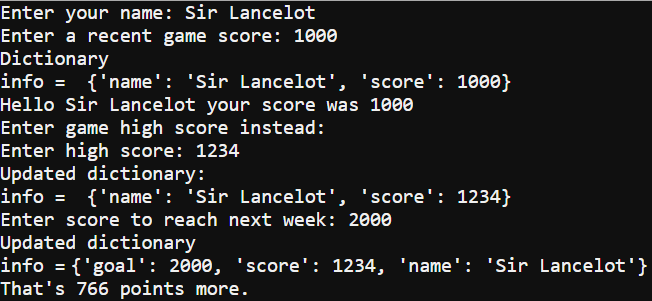- Change project's name from interactive_dictionary_try_this to interactive_dictionary_your_turn.
- Add these statements to the end of the script you’ve been building.
- Save the modified script.
- Click the Send to micro:bit button.
text = input("Enter score to reach next week: ")
value = int(text)
info['goal'] = value
print("Updated dictionary")
print("info = ", info)
text = info['score']
score = int(text)
text = info['goal']
score_goal = int(text)
difference = score_goal - score
print("That's", difference, "points more.")
- Click the the right of the Enter your name: prompt in the serial monitor.
- To make it match the example shown here, enter the same values as before, and then enter 2000 when prompted to enter the score to reach next week.
- Verify that the updated dictionary that gets displayed is info = {'goal': 2000, 'score' : 1234, 'name': 'Sir Lancelot'}.
- Verify that it displays That’s 766 points more.

Look what happened to the key-value pairs. The MicroPython runtime interpreter changed the order when you added the goal': 2000 pair. Again, that change in order did not matter because the script used the 'score' and 'goal' keys to look up the values that got stored in the score and score_goal variables. Then, the script used these values to correctly calculate:
difference = score_goal - score
= 2000 - 1234
= 766.
